Case Study Plan: Automated Vehicles - ENGR9742 Assignment 2
VerifiedAdded on 2020/03/23
|5
|1029
|69
Report
AI Summary
This report presents a case study plan on automated vehicles, addressing safety concerns, human factors, and risk management. The report includes an annotated bibliography with three references exploring human-like driving behavior, risk management issues, and human factor challenges. The abstract summarizes the advantages of self-driven cars, such as reduced emissions and accidents, while highlighting the need for human involvement in critical decision-making, especially in adverse conditions. It emphasizes the importance of Human Machine Interface (HMI) for maintaining driver situational awareness and the need for robust legal liability policies and cyber security measures. The study also touches on the importance of driver state assessment technology and the collaborative efforts required from state, car companies, and owners in the development and implementation of automated vehicle systems. The assignment, contributed by a student, is available on Desklib, a platform offering AI-based study tools.
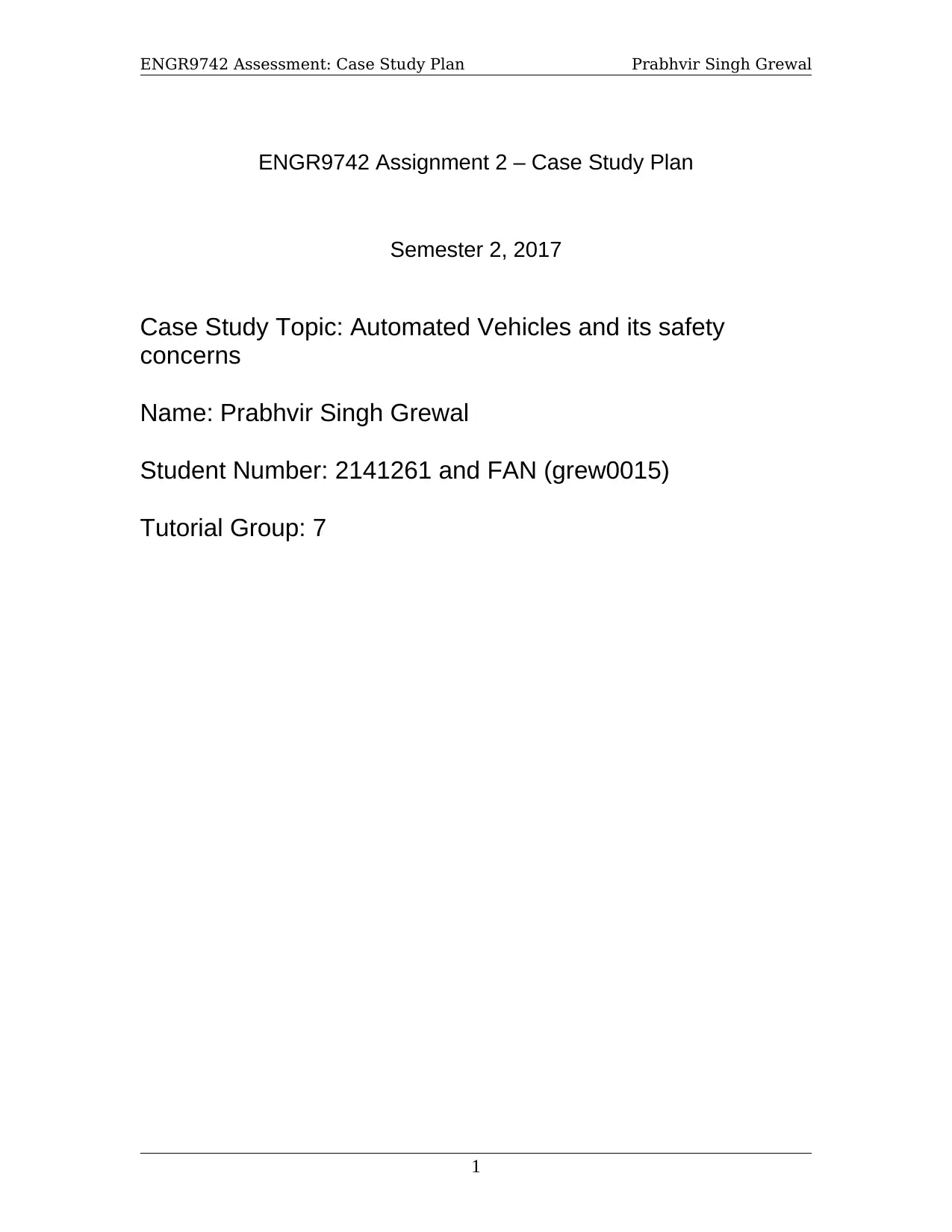
ENGR9742 Assessment: Case Study Plan Prabhvir Singh Grewal
ENGR9742 Assignment 2 – Case Study Plan
Semester 2, 2017
Case Study Topic: Automated Vehicles and its safety
concerns
Name: Prabhvir Singh Grewal
Student Number: 2141261 and FAN (grew0015)
Tutorial Group: 7
1
ENGR9742 Assignment 2 – Case Study Plan
Semester 2, 2017
Case Study Topic: Automated Vehicles and its safety
concerns
Name: Prabhvir Singh Grewal
Student Number: 2141261 and FAN (grew0015)
Tutorial Group: 7
1
Paraphrase This Document
Need a fresh take? Get an instant paraphrase of this document with our AI Paraphraser
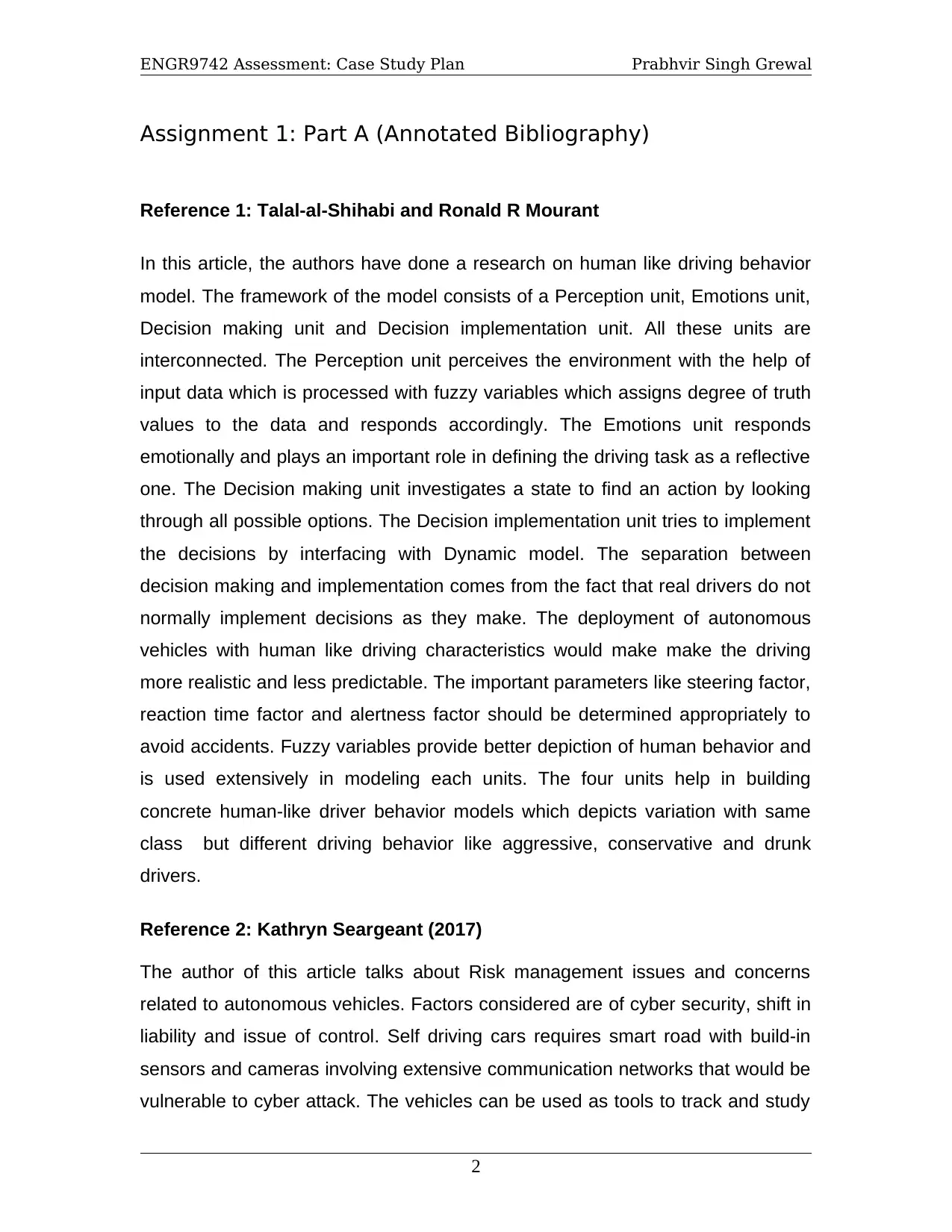
ENGR9742 Assessment: Case Study Plan Prabhvir Singh Grewal
Assignment 1: Part A (Annotated Bibliography)
Reference 1: Talal-al-Shihabi and Ronald R Mourant
In this article, the authors have done a research on human like driving behavior
model. The framework of the model consists of a Perception unit, Emotions unit,
Decision making unit and Decision implementation unit. All these units are
interconnected. The Perception unit perceives the environment with the help of
input data which is processed with fuzzy variables which assigns degree of truth
values to the data and responds accordingly. The Emotions unit responds
emotionally and plays an important role in defining the driving task as a reflective
one. The Decision making unit investigates a state to find an action by looking
through all possible options. The Decision implementation unit tries to implement
the decisions by interfacing with Dynamic model. The separation between
decision making and implementation comes from the fact that real drivers do not
normally implement decisions as they make. The deployment of autonomous
vehicles with human like driving characteristics would make make the driving
more realistic and less predictable. The important parameters like steering factor,
reaction time factor and alertness factor should be determined appropriately to
avoid accidents. Fuzzy variables provide better depiction of human behavior and
is used extensively in modeling each units. The four units help in building
concrete human-like driver behavior models which depicts variation with same
class but different driving behavior like aggressive, conservative and drunk
drivers.
Reference 2: Kathryn Seargeant (2017)
The author of this article talks about Risk management issues and concerns
related to autonomous vehicles. Factors considered are of cyber security, shift in
liability and issue of control. Self driving cars requires smart road with build-in
sensors and cameras involving extensive communication networks that would be
vulnerable to cyber attack. The vehicles can be used as tools to track and study
2
Assignment 1: Part A (Annotated Bibliography)
Reference 1: Talal-al-Shihabi and Ronald R Mourant
In this article, the authors have done a research on human like driving behavior
model. The framework of the model consists of a Perception unit, Emotions unit,
Decision making unit and Decision implementation unit. All these units are
interconnected. The Perception unit perceives the environment with the help of
input data which is processed with fuzzy variables which assigns degree of truth
values to the data and responds accordingly. The Emotions unit responds
emotionally and plays an important role in defining the driving task as a reflective
one. The Decision making unit investigates a state to find an action by looking
through all possible options. The Decision implementation unit tries to implement
the decisions by interfacing with Dynamic model. The separation between
decision making and implementation comes from the fact that real drivers do not
normally implement decisions as they make. The deployment of autonomous
vehicles with human like driving characteristics would make make the driving
more realistic and less predictable. The important parameters like steering factor,
reaction time factor and alertness factor should be determined appropriately to
avoid accidents. Fuzzy variables provide better depiction of human behavior and
is used extensively in modeling each units. The four units help in building
concrete human-like driver behavior models which depicts variation with same
class but different driving behavior like aggressive, conservative and drunk
drivers.
Reference 2: Kathryn Seargeant (2017)
The author of this article talks about Risk management issues and concerns
related to autonomous vehicles. Factors considered are of cyber security, shift in
liability and issue of control. Self driving cars requires smart road with build-in
sensors and cameras involving extensive communication networks that would be
vulnerable to cyber attack. The vehicles can be used as tools to track and study
2
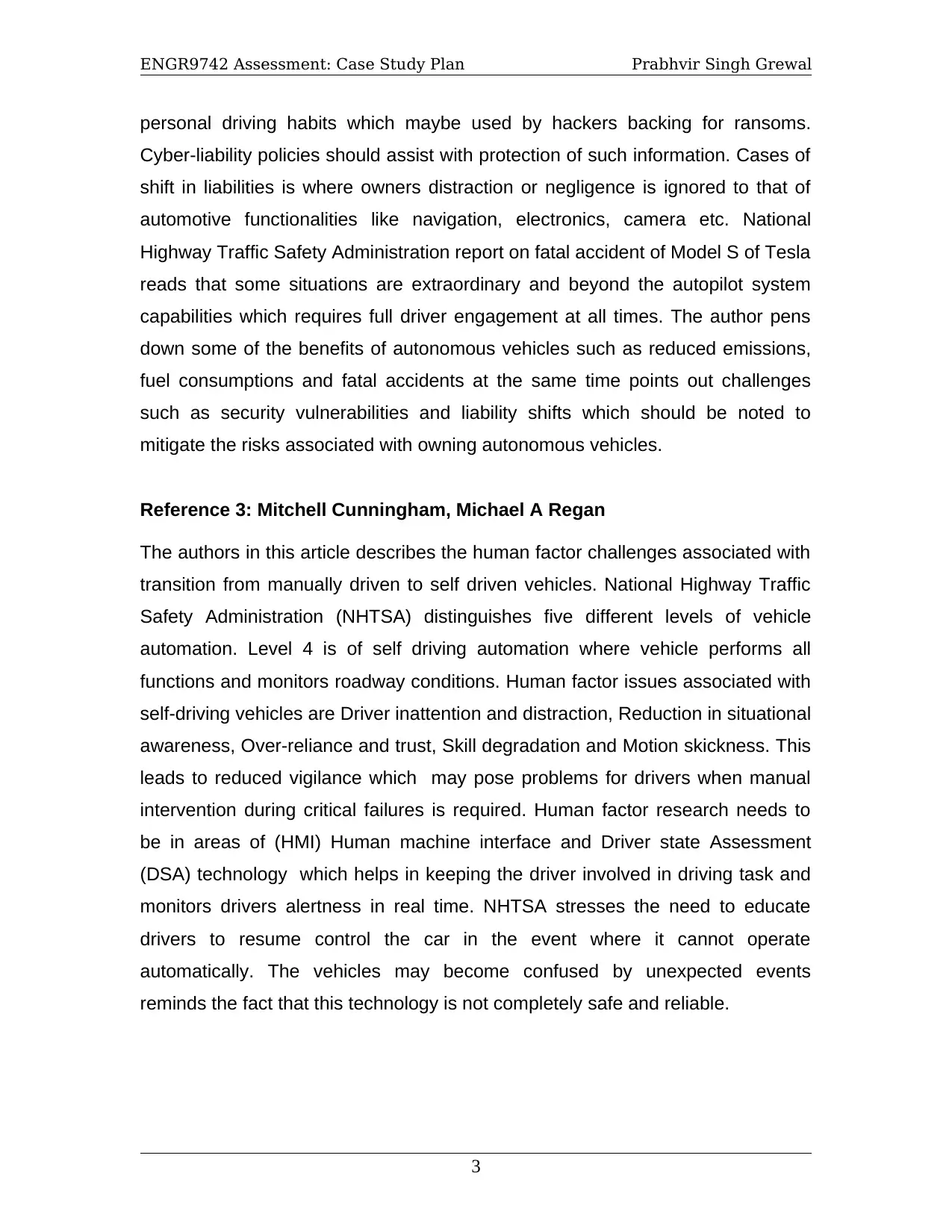
ENGR9742 Assessment: Case Study Plan Prabhvir Singh Grewal
personal driving habits which maybe used by hackers backing for ransoms.
Cyber-liability policies should assist with protection of such information. Cases of
shift in liabilities is where owners distraction or negligence is ignored to that of
automotive functionalities like navigation, electronics, camera etc. National
Highway Traffic Safety Administration report on fatal accident of Model S of Tesla
reads that some situations are extraordinary and beyond the autopilot system
capabilities which requires full driver engagement at all times. The author pens
down some of the benefits of autonomous vehicles such as reduced emissions,
fuel consumptions and fatal accidents at the same time points out challenges
such as security vulnerabilities and liability shifts which should be noted to
mitigate the risks associated with owning autonomous vehicles.
Reference 3: Mitchell Cunningham, Michael A Regan
The authors in this article describes the human factor challenges associated with
transition from manually driven to self driven vehicles. National Highway Traffic
Safety Administration (NHTSA) distinguishes five different levels of vehicle
automation. Level 4 is of self driving automation where vehicle performs all
functions and monitors roadway conditions. Human factor issues associated with
self-driving vehicles are Driver inattention and distraction, Reduction in situational
awareness, Over-reliance and trust, Skill degradation and Motion skickness. This
leads to reduced vigilance which may pose problems for drivers when manual
intervention during critical failures is required. Human factor research needs to
be in areas of (HMI) Human machine interface and Driver state Assessment
(DSA) technology which helps in keeping the driver involved in driving task and
monitors drivers alertness in real time. NHTSA stresses the need to educate
drivers to resume control the car in the event where it cannot operate
automatically. The vehicles may become confused by unexpected events
reminds the fact that this technology is not completely safe and reliable.
3
personal driving habits which maybe used by hackers backing for ransoms.
Cyber-liability policies should assist with protection of such information. Cases of
shift in liabilities is where owners distraction or negligence is ignored to that of
automotive functionalities like navigation, electronics, camera etc. National
Highway Traffic Safety Administration report on fatal accident of Model S of Tesla
reads that some situations are extraordinary and beyond the autopilot system
capabilities which requires full driver engagement at all times. The author pens
down some of the benefits of autonomous vehicles such as reduced emissions,
fuel consumptions and fatal accidents at the same time points out challenges
such as security vulnerabilities and liability shifts which should be noted to
mitigate the risks associated with owning autonomous vehicles.
Reference 3: Mitchell Cunningham, Michael A Regan
The authors in this article describes the human factor challenges associated with
transition from manually driven to self driven vehicles. National Highway Traffic
Safety Administration (NHTSA) distinguishes five different levels of vehicle
automation. Level 4 is of self driving automation where vehicle performs all
functions and monitors roadway conditions. Human factor issues associated with
self-driving vehicles are Driver inattention and distraction, Reduction in situational
awareness, Over-reliance and trust, Skill degradation and Motion skickness. This
leads to reduced vigilance which may pose problems for drivers when manual
intervention during critical failures is required. Human factor research needs to
be in areas of (HMI) Human machine interface and Driver state Assessment
(DSA) technology which helps in keeping the driver involved in driving task and
monitors drivers alertness in real time. NHTSA stresses the need to educate
drivers to resume control the car in the event where it cannot operate
automatically. The vehicles may become confused by unexpected events
reminds the fact that this technology is not completely safe and reliable.
3
⊘ This is a preview!⊘
Do you want full access?
Subscribe today to unlock all pages.

Trusted by 1+ million students worldwide
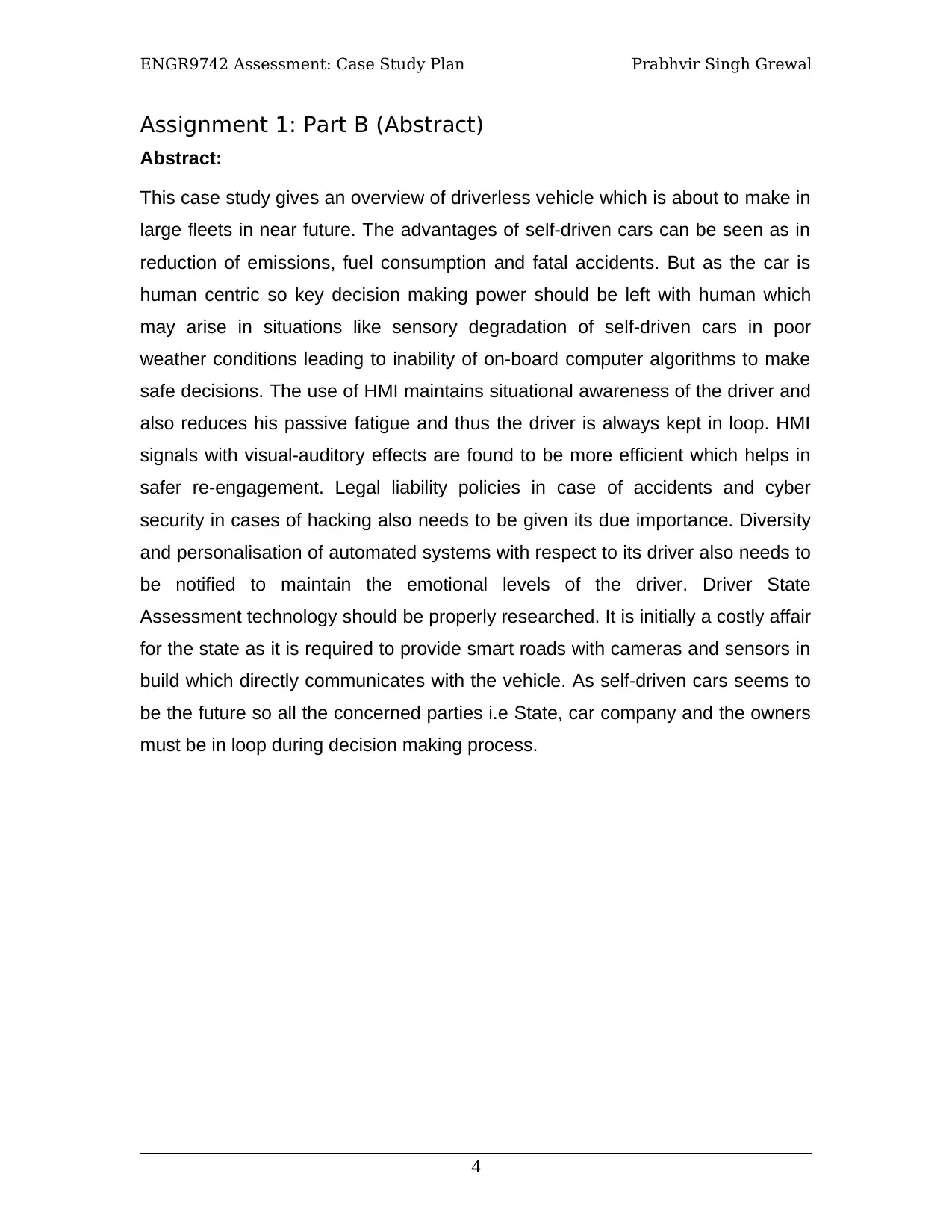
ENGR9742 Assessment: Case Study Plan Prabhvir Singh Grewal
Assignment 1: Part B (Abstract)
Abstract:
This case study gives an overview of driverless vehicle which is about to make in
large fleets in near future. The advantages of self-driven cars can be seen as in
reduction of emissions, fuel consumption and fatal accidents. But as the car is
human centric so key decision making power should be left with human which
may arise in situations like sensory degradation of self-driven cars in poor
weather conditions leading to inability of on-board computer algorithms to make
safe decisions. The use of HMI maintains situational awareness of the driver and
also reduces his passive fatigue and thus the driver is always kept in loop. HMI
signals with visual-auditory effects are found to be more efficient which helps in
safer re-engagement. Legal liability policies in case of accidents and cyber
security in cases of hacking also needs to be given its due importance. Diversity
and personalisation of automated systems with respect to its driver also needs to
be notified to maintain the emotional levels of the driver. Driver State
Assessment technology should be properly researched. It is initially a costly affair
for the state as it is required to provide smart roads with cameras and sensors in
build which directly communicates with the vehicle. As self-driven cars seems to
be the future so all the concerned parties i.e State, car company and the owners
must be in loop during decision making process.
4
Assignment 1: Part B (Abstract)
Abstract:
This case study gives an overview of driverless vehicle which is about to make in
large fleets in near future. The advantages of self-driven cars can be seen as in
reduction of emissions, fuel consumption and fatal accidents. But as the car is
human centric so key decision making power should be left with human which
may arise in situations like sensory degradation of self-driven cars in poor
weather conditions leading to inability of on-board computer algorithms to make
safe decisions. The use of HMI maintains situational awareness of the driver and
also reduces his passive fatigue and thus the driver is always kept in loop. HMI
signals with visual-auditory effects are found to be more efficient which helps in
safer re-engagement. Legal liability policies in case of accidents and cyber
security in cases of hacking also needs to be given its due importance. Diversity
and personalisation of automated systems with respect to its driver also needs to
be notified to maintain the emotional levels of the driver. Driver State
Assessment technology should be properly researched. It is initially a costly affair
for the state as it is required to provide smart roads with cameras and sensors in
build which directly communicates with the vehicle. As self-driven cars seems to
be the future so all the concerned parties i.e State, car company and the owners
must be in loop during decision making process.
4
Paraphrase This Document
Need a fresh take? Get an instant paraphrase of this document with our AI Paraphraser
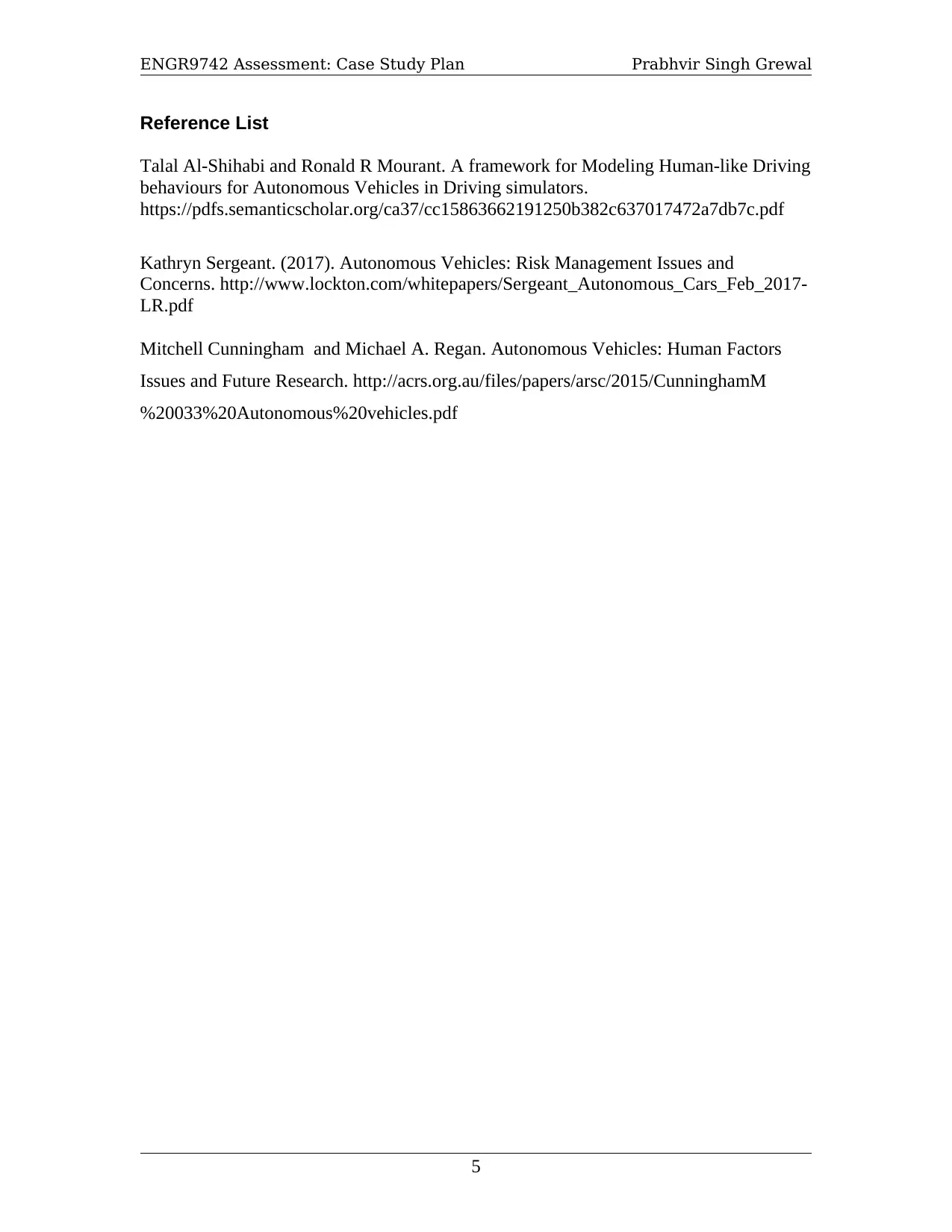
ENGR9742 Assessment: Case Study Plan Prabhvir Singh Grewal
Reference List
Talal Al-Shihabi and Ronald R Mourant. A framework for Modeling Human-like Driving
behaviours for Autonomous Vehicles in Driving simulators.
https://pdfs.semanticscholar.org/ca37/cc15863662191250b382c637017472a7db7c.pdf
Kathryn Sergeant. (2017). Autonomous Vehicles: Risk Management Issues and
Concerns. http://www.lockton.com/whitepapers/Sergeant_Autonomous_Cars_Feb_2017-
LR.pdf
Mitchell Cunningham and Michael A. Regan. Autonomous Vehicles: Human Factors
Issues and Future Research. http://acrs.org.au/files/papers/arsc/2015/CunninghamM
%20033%20Autonomous%20vehicles.pdf
5
Reference List
Talal Al-Shihabi and Ronald R Mourant. A framework for Modeling Human-like Driving
behaviours for Autonomous Vehicles in Driving simulators.
https://pdfs.semanticscholar.org/ca37/cc15863662191250b382c637017472a7db7c.pdf
Kathryn Sergeant. (2017). Autonomous Vehicles: Risk Management Issues and
Concerns. http://www.lockton.com/whitepapers/Sergeant_Autonomous_Cars_Feb_2017-
LR.pdf
Mitchell Cunningham and Michael A. Regan. Autonomous Vehicles: Human Factors
Issues and Future Research. http://acrs.org.au/files/papers/arsc/2015/CunninghamM
%20033%20Autonomous%20vehicles.pdf
5
1 out of 5
Related Documents
Your All-in-One AI-Powered Toolkit for Academic Success.
+13062052269
info@desklib.com
Available 24*7 on WhatsApp / Email
![[object Object]](/_next/static/media/star-bottom.7253800d.svg)
Unlock your academic potential
Copyright © 2020–2025 A2Z Services. All Rights Reserved. Developed and managed by ZUCOL.





